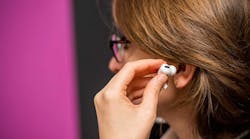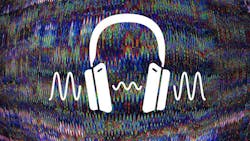Control Ambient Noise Through Isolation and Cancellation
This article is part of the TechXchange: Delving into EMI, EMC and Noise.
Members can download this article in PDF format.
What you'll learn:
- Defining noise isolation and noise cancellation.
- Methods for controlling electronic/electrical noise.
- Digital isolator or optocoupler?
The most obvious way to get rid of ambient noise is to employ some form of passive or active noise cancellation (ANC). The type of ANC we’re familiar with today was coined in 1989 by Dr. Amar Bose with the Series I Aviation Headset by Bose Aviation.
Noise Isolation and Cancellation
Passive noise isolation can be accomplished by blocking ambient sound using physical barriers. When we cover our ears with our palms, we reduce ambient noise. Headphones, with foam pads in the ear cups, are creating a secure seal around our ears that isolates your ear from any ambient sound. This easy method is only mildly effective—any sound, albeit lower in volume, will still get through to our ears, depending on the fit, materials, and design of the headphones.
Active noise isolation (or ANC) uses a system of components that are placed within the ear cups of headphones. This offers a better means to block off ambient sound. Tiny microphones “listen” to the ambient sound all around us, leading to the sound wave data that will be relayed to a built-in chipset. That chipset will enable algorithms to produce an opposing soundwave (180 degrees out of phase with the noise) through the speakers and into our ears. This will cancel out incoming ambient sound waves.
Some common methods to control electronic/electrical noise in systems include:
Noise isolation
Noise isolation is also known as “passive noise cancellation.” This method blocks pesky noise via the usage of physical barriers like your hands or headphones.
Environmental noise cancellation (ENC)1
It’s all around us! That is… environmental noise! Many of us who live or have lived in a busy metropolis like I did in Brooklyn, N.Y., just got used to the constant drone of motor vehicles (thank you for electric vehicles) and noisy clanking, screeching, whining, and more.
Active Noise Cancellation Explained: What Is ANC in Headphones?
Headphones achieve phase cancellation for their ANC features via two primary components:3
- Beamforming microphones: These are used to record environmental noise.
- Sound cards: Typically, a digital signal processor (DSP) will be employed. The card receives the noise signal and intervenes in its phase character.
A headphone performs ANC in this manner:
- Headphones, with a beamforming microphone, will record the listening environment.
- The audio is then picked up by the microphone(s) and that audio is sent to the DSP in the headphone electronics.
- The DSP will then invert the phase of the received audio.
- The noise is cancelled or significantly reduced via phase cancellation. It occurs when the sound waves, from the environment, get added to their phase-flipped duplicates, which are produced via a DSP and speakers within the headphones.
Phase cancellation uses identical waves, 180 degrees out of phase, which will cancel each other. This action makes the ANC effect possible (see figure).
Typically, non-ANC headphones can reduce any sounds at mid-to-high frequencies as much as 15 to 30 dB. These types of headphones aren’t very effective at reducing any low-frequency sounds (20 to 800 Hz), such as the noise from car engines, aircraft engines, and air conditioners.
So, ANC headphones are able to typically block an added 30 dB of low-frequency noise below 1 kHz. ANC headphones can also reduce ambient sound by as much as 60 dB. This will depend on the use of active and passive components used in the headphone electronics.
ANC performs best when reducing noise that repeats, such as an air-conditioner vibration. However, reduction isn’t as good with sudden loud noises.
There are shortfalls with ANC, though. This is because ANC functions via the recording of ambient noise and will process this noise before the speaker output. Unfortunately, latency is a nasty shortcoming in ANC systems, regardless of using a feedback or feedforward structure.
A multi-rate signal-processing method can minimize electronic delay within the control loop. This technique employs digital controllers that are necessary in the interpolation and decimation of discrete-time signals. Computation efficiency can be further enhanced by using a polyphase method. This approach necessitates the use of phases of low-pass finite-impulse-response (FIR) filters that must be carefully designed to avoid unnecessary delays.
Acoustic hear-through technology
Standard in-ear headphones have a high-level isolation. Ambient sounds which are transmitted to our eardrum will get attenuated as they flow through headphones being worn by users.
Acoustic hear-through (HT), a.k.a. the acoustic transparent transmission technique, is used to enable the natural listening of ambient sounds for users wearing headphones.4,5 If the in-ear headphones have ANC, the design of an acoustic HT digital filter can embed the headphone system with that HT function.
When combined with the speech spectral subtraction algorithm, the speech enhancement is applied based on the HT system to achieve selective HT of noisy speech.
Through experiments and simulation, a full-band HT filter has been designed using known actual acoustic transmission path parameters that are combined with hardware conditions. The transfer function has been compared with that of a system without headphones or HT headphones. The result led to superior HT performance that was accomplished in the observed frequency band.
Best Grounding Techniques to Minimize Noise
Many methods will help to lower noise in electronic circuitry such as the use of a star ground, differential signal path, or a robust ground plane. Electromagnetic-compatibility (EMC) grounding employs an equipotential point/plane that’s a reference point for all circuit components. This serves as a low-impedance path that enables the current to return to the signal source.
Robust EMC grounding is needed to minimize emissions, coupling interference, and susceptibility. Designers must observe the signal’s frequency, amplitude of the current, an effective impedance path, and the maximum voltage noise that the circuitry must be able to tolerate. Designers must be aware of improperly grounded circuitry that can create common-mode noise in the circuitry.
Higher levels of EMI will appear with a large area of ground loops and a high impedance in the grounding path.
Digital Isolators vs. Optocouplers
Digital isolators have many advantages over optocouplers, such as size, speed, power consumption, ease of use, and reliability.9
Optocouplers (i.e., optical isolators) are an effective, alternative isolation technology as compared to digital isolators. Optocouplers use LEDs to transmit light data across an isolation barrier: When the LED turns on, the optocoupler burns power; thus, they’re a poor choice when power consumption is a concern.
Digital isolators, in many cases, may prove to be a better solution for myriad types of applications. Digital isolators have the advantage of better power-consumption efficiency, faster data rates, and lower propagation delays than optocouplers. Digital isolators also offer higher reliability than optocouplers because they don’t suffer from such issues as LED failures or interface contamination.
Designers should use short trace lengths between a digital or optical isolator and the surrounding circuitry. This will help prevent any noise pickup.
Also, digital and optical isolators may be used with isolated DC-DC converters, which enables supply power across the isolation barrier.
Single-ended transmission signaling is sensitive to noise pickup. The 500-kHz to 3-MHz switching frequencies, from DC-DC converters nearby, can be picked up via long signal traces.
More Noise Isolation and Cancellation Techniques
Signal averaging (SA)
Signal averaging is a technique to increase signal-to-noise ratio (SNR). It may be applied in such fields as nanotechnology and biomedical engineering. If we assume that the noise is random and of zero mean, its average across multiple signals will tend towards zero. (Zero-mean noise is a random signal that will not exhibit any net disturbance or bias. The signal will oscillate randomly around a true value; the positive and negative values will eventually cancel each other out. Zero-mean noise is serially uncorrelated, so that each sample is independent of the previous ones.)
A good example of zero-mean noise is white noise, which has a constant power spectrum. Every additional measurement in the average should lead to raising the SNR. For the SA to function, averaged signals should be in-phase. If these signals aren’t in-phase, the obtained average will not be accurately characterizing the sampled signals. That’s because their unique fragments will be repeated or distorted.
Filters
There are four main filter types for circuits:
- Low-pass filter: Prevents high-frequency signals from passing through.
- High-pass filter: Prevents low-frequency signals from passing through.
- Bandpass filter: Only a certain range of frequencies can pass through.
- Notch/band-reject filter: Blocks a specific range of frequencies.
Amplifiers with differential inputs
Differential circuits will always offer better performance over single-ended circuits.10 Differential circuits provide higher linearity and immunity to common-mode interference signals.
Summary
This article provides noise isolation and cancellation techniques. Sometimes, combinations of these methods will further enhance the noise cancellation capability. Headphones, earplugs, or earphones typically appear at the top of the list of methods to employ.
A passive method in noise isolation is the physical blocking of any external sounds from reaching the human ear. It relies on the design and construction of headphones or earbuds to create a seal around the ears or within the ear canal, preventing outside noise from seeping in.
Noise cancellation is defined as an active technique which employs electronic circuitry and external microphones that will counteract any incoming sounds. It proves more effective for low, constant sounds, while noise isolation is better for mid-to-high frequencies.
Read more articles in the TechXchange: Delving into EMI, EMC and Noise.
References
1. “Explain About Environmental Noise Cancellation (ENC)?,” Chaitanya, ElectronicsHub 2023.
2. “Noise Cancelling vs. Noise Isolating: Which Is Better?,” Colin Toh, Headphonesty, 2023.
3. “Active Noise Cancellation Explained: What Is ANC in Headphones?,” Headphonesty, 2023.
4. “A Research on Acoustic Hear-Through Technology Based on an Active Noise Cancellation Headphone System,” Mengyao Jia, Ning Han*, Lingchen Zhou, 2022 14th International Conference on Signal Processing Systems (ICSPS), IEEE Xplore.
5. “In-ear vs over-ear headphones: what is better for hearing health?,” August 28, 2023, EarPros
6. “Using EMC grounding techniques to build noise immune circuits,” Cadence, 2021
7. “What's the Difference Between Noise Isolation and Noise Cancellation?,” How-to Geek, Vann Vicente, 2022.
8. “Exploring Digital Isolator Technology, William G. Wong,” Electronic Design.
9. “Digital Isolator Design Guide,” SLLA284G-July 2022_Revised September 2023, Texas Instruments.
10. “Understanding and Designing Differential Filters for Communications Systems,” Analog Devices.


